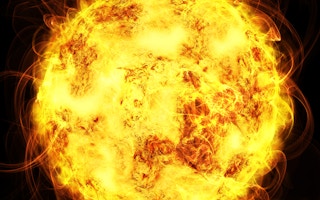Changes in solar activity, sunspots and cosmic rays, and their effects on clouds, have contributed no more than 10% to global warming, according to two British scientists.
The findings, published in the journal Environmental Research Letters, revisit the basic science that it is increasing carbon dioxide and other greenhouse gases that are causing most climate change. They also re-examine the alternative case made by climate deniers: that it is the Sun’s changing activity and not us that is causing the Earth to heat up.
The two scientists, Professor Terry Sloan at the University of Lancaster and Professor Sir Arnold Wolfendale at the University of Durham, conclude that neither changes in the activity of the Sun, nor its impact in blocking cosmic rays, can be a significant contributor to global warming.
Clouds and their role in keeping the Earth’s surface cool by reflecting sunlight back into space have been one of the biggest uncertainties of climate change science.
The acknowledged role of sunspots and cosmic rays in forming clouds has been fertile ground for climate deniers, who have cast doubt on whether anthropogenic climate change (in other words, change caused by humans) is occurring at all.
Eleven-year cycle
Sunspot activity, which ebbs and flows on an 11-year cycle, decreases the cosmic ray flux by periodically increasing the solar wind – a stream of charged particles emitted by the Sun.
The solar wind’s greater magnetic field deflects away some of the cosmic rays that would otherwise hit the Earth from elsewhere in the galaxy. So, if the theory linking cosmic rays and cloud formation is correct, increased sunspot activity could potentially reduce cloud cover.
To try to quantify the effect that solar activity – whether directly or through cosmic rays -may have had on global temperatures in the twentieth century, Sloan and Wolfendale compared data on the rate of cosmic rays entering the atmosphere with the record of global temperatures going back to 1955.
They found a small correlation between cosmic rays and global temperatures occurring every 22 years; however, the changing cosmic ray rate lagged behind the change in temperatures by between one and two years, suggesting that the cause of the temperature rise might not be attributable to cosmic rays and cloud formation, but could be caused by the direct effects of the Sun.
Nuclear tests
By comparing the small oscillations in cosmic ray rate and temperature with the overall trends in both since 1955, Sloan and Wolfendale found that less than 14% of the global warming seen during this period could have been caused by solar activity.
To check their findings they reviewed their own previous studies and all the other work they could find on the subject, to see whether they could find other evidence of a link between solar activity and increasing global temperatures.
Their findings indicated that, overall, the contribution of changing solar activity, either directly or through cosmic rays, was even less and cannot have contributed more than 10% to global warming in the twentieth century.
Sloan and Wolfendale also discussed the results from an experiment at CERN in Switzerland called CLOUD, where researchers are looking at ways in which cosmic rays can ionize, or charge, aerosols in the atmosphere, which can then influence how clouds are formed. They also examined instances where real-world events produced large-scale ionization in the atmosphere.
Events such as the Chernobyl nuclear disaster and nuclear weapons testing would have been expected to affect aerosol production in the atmosphere, but no such effects could be seen.
Professor Sloan said: “Our paper reviews our work to try and find a connection between cosmic rays and cloud formation with changes in global temperature.
“We conclude that the level of contribution of changing solar activity is less than 10% of the measured global warming observed in the twentieth century. As a result of this and other work, the Intergovernmental Panel on Climate Change state that no robust association between changes in cosmic rays and cloudiness has been identified.”










